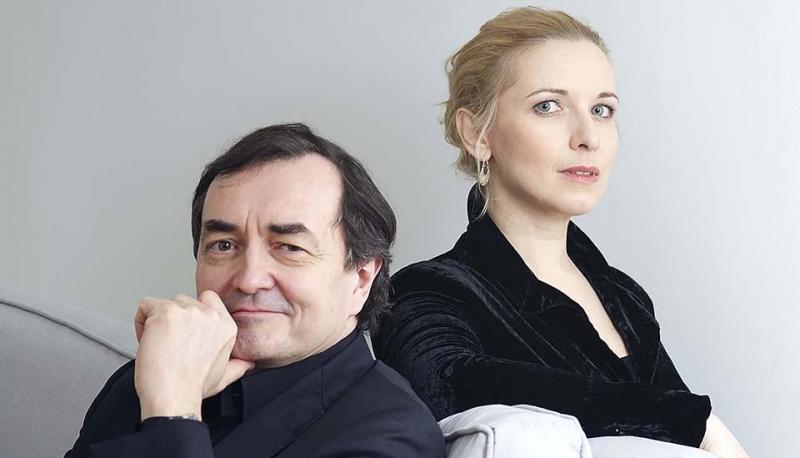Aimard, Stefanovich, St John's Smith Square | reviews, news & interviews
Aimard, Stefanovich, St John's Smith Square
Aimard, Stefanovich, St John's Smith Square
Superlative Messiaen, but Brahms disappoints

Visions de l’Amen was a shoo-in for Belief and Beyond Belief, the year-long festival of art inspired by religious faith. The festival’s goals seem dangerously nebulous – almost anything could fit its remit – but it is hard to imagine a work that better encapsulates "The Search for the Meaning of Life" than Messiaen’s transcendental masterpiece.
Brahms, however, was less lucky, and had the odds stacked against him from the start. Coupling his Sonata for Two Pianos with Messiaen only served to emphasise his stubborn atheism and its imprint on his work – no searching for the meaning of life here. Brahms himself was unhappy with the sonata and later rearranged it into his famous Piano Quintet. That work casts a long shadow over its predecessor, and it was clear from overheard discussions in the interval that many in the audience had spent the first half listening along to the Quintet in their minds.
The unity of the two artists’ conception always transcended the contrasts in the score
St John’s Smith Square was unkind to Brahms as well. His finely wrought textures lacked detail in the resonant church acoustic, and each of the climaxes dissolved into a wash of sound. But there was clarity, at least, in the quieter music, where the two pianos presented Brahms’s intricate and often surprising chord sequences with an unadorned directness rarely heard it the quintet version.
Aimard and Stefanovich gave a reading that moved between high passion and repressed formality. The outer movements were impressively lively and engaged, with a wide dynamic range from both players, united by a clear unity of intent and spot-on synchronisation. It was surprising, though, to hear occasional slips and insecure passagework at both keyboards – the Sonata clearly posing technical challenges even to these formidable talents. The formality crept in in the second and third movements. The Andante second was taken slow, painfully so, or so it seemed from Aimard’s face as he struggled to hold back to the chosen tempo. There was more texture and subtlety to the Scherzo, though sadly marred by Stefanovich crudely exaggerating the appoggiatura ornaments in the melody. The drama of the finale returned the players to form, and the huge crescendo into the coda was perfectly gauged, with the piece finishing on a real high.
 Pierre-Laurent Aimard’s credentials for Visions de l’Amen are second to none. Messiaen wrote the work for performance by himself and his wife, Yvonne Loriod, and Aimard later studied with both. He even turned pages in their performances of the work (no mean feat in itself). When the work was written, Loriod was Messiaen’s pupil, just as Stefanovich was Aimard’s. Those parallels are keenly felt when Aimard and Stefanovich perform the work, and it is easy to imagine Aimard as the composer, performing the dark and psychologically intense second part, while his pupil complements with the virtuoso filigree of the first. Unlike in the Brahms, the two parts here have very distinct identities, but this only serves to emphasise the unity of the two artists’ conception, always transcending the contrasts in the score. And after the awkward formality of the Brahms, this was a performance of continuously fluid tempos and broad, expressive playing. Even the acoustic was on Messiaen’s side, blending the colours and textures of his swirling, impressionistic climaxes, while still retaining rhythmic incisiveness and percussive urgency.
Pierre-Laurent Aimard’s credentials for Visions de l’Amen are second to none. Messiaen wrote the work for performance by himself and his wife, Yvonne Loriod, and Aimard later studied with both. He even turned pages in their performances of the work (no mean feat in itself). When the work was written, Loriod was Messiaen’s pupil, just as Stefanovich was Aimard’s. Those parallels are keenly felt when Aimard and Stefanovich perform the work, and it is easy to imagine Aimard as the composer, performing the dark and psychologically intense second part, while his pupil complements with the virtuoso filigree of the first. Unlike in the Brahms, the two parts here have very distinct identities, but this only serves to emphasise the unity of the two artists’ conception, always transcending the contrasts in the score. And after the awkward formality of the Brahms, this was a performance of continuously fluid tempos and broad, expressive playing. Even the acoustic was on Messiaen’s side, blending the colours and textures of his swirling, impressionistic climaxes, while still retaining rhythmic incisiveness and percussive urgency.
A game of two halves, then, with the Brahms a curious filler for a concert that was all about Messiaen. But any frustrations about the first half were quickly forgotten in the second, with a Messiaen performance as good as any you’re likely to hear, and from pianists whose authority in this repertoire is matched by their immediacy, passion, and... yes... engagement with the big issues: Belief, the meaning of life, it’s all here.
- This concert was broadcast live on BBC Radio 3 and is available to listen on demand.
- Read more classical music reviews on theartsdesk
rating
Explore topics
Share this article
Add comment
more Classical music
 Christian Pierre La Marca, Yaman Okur, St Martin-in-The-Fields review - engagingly subversive pairing falls short
A collaboration between a cellist and a breakdancer doesn't achieve lift off
Christian Pierre La Marca, Yaman Okur, St Martin-in-The-Fields review - engagingly subversive pairing falls short
A collaboration between a cellist and a breakdancer doesn't achieve lift off
 Ridout, Włoszczowska, Crawford, Lai, Posner, Wigmore Hall review - electrifying teamwork
High-voltage Mozart and Schoenberg, blended Brahms, in a fascinating programme
Ridout, Włoszczowska, Crawford, Lai, Posner, Wigmore Hall review - electrifying teamwork
High-voltage Mozart and Schoenberg, blended Brahms, in a fascinating programme
 Sabine Devieilhe, Mathieu Pordoy, Wigmore Hall review - enchantment in Mozart and Strauss
Leading French soprano shines beyond diva excess
Sabine Devieilhe, Mathieu Pordoy, Wigmore Hall review - enchantment in Mozart and Strauss
Leading French soprano shines beyond diva excess
 Špaček, BBC Philharmonic, Bihlmaier, Bridgewater Hall, Manchester review - three flavours of Vienna
Close attention, careful balancing, flowing phrasing and clear contrast
Špaček, BBC Philharmonic, Bihlmaier, Bridgewater Hall, Manchester review - three flavours of Vienna
Close attention, careful balancing, flowing phrasing and clear contrast
 Watts, BBC Symphony Orchestra and Chorus, Bignamini, Barbican review - blazing French masterpieces
Poulenc’s Gloria and Berlioz’s 'Symphonie fantastique' on fire
Watts, BBC Symphony Orchestra and Chorus, Bignamini, Barbican review - blazing French masterpieces
Poulenc’s Gloria and Berlioz’s 'Symphonie fantastique' on fire
 Bell, Perahia, ASMF Chamber Ensemble, Wigmore Hall review - joy in teamwork
A great pianist re-emerges in Schumann, but Beamish and Mendelssohn take the palm
Bell, Perahia, ASMF Chamber Ensemble, Wigmore Hall review - joy in teamwork
A great pianist re-emerges in Schumann, but Beamish and Mendelssohn take the palm
 First Persons: composers Colin Alexander and Héloïse Werner on fantasy in guided improvisation
On five new works allowing an element of freedom in the performance
First Persons: composers Colin Alexander and Héloïse Werner on fantasy in guided improvisation
On five new works allowing an element of freedom in the performance
 First Person: Leeds Lieder Festival director and pianist Joseph Middleton on a beloved organisation back from the brink
Arts Council funding restored after the blow of 2023, new paths are being forged
First Person: Leeds Lieder Festival director and pianist Joseph Middleton on a beloved organisation back from the brink
Arts Council funding restored after the blow of 2023, new paths are being forged
 Classical CDs: Nymphs, magots and buckgoats
Epic symphonies, popular music from 17th century London and an engrossing tribute to a great Spanish pianist
Classical CDs: Nymphs, magots and buckgoats
Epic symphonies, popular music from 17th century London and an engrossing tribute to a great Spanish pianist
 Sheku Kanneh-Mason, Philharmonia Chorus, RPO, Petrenko, RFH review - poetic cello, blazing chorus
Atmospheric Elgar and Weinberg, but Rachmaninov's 'The Bells' takes the palm
Sheku Kanneh-Mason, Philharmonia Chorus, RPO, Petrenko, RFH review - poetic cello, blazing chorus
Atmospheric Elgar and Weinberg, but Rachmaninov's 'The Bells' takes the palm
 Daphnis et Chloé, Tenebrae, LSO, Pappano, Barbican review - lighting up Ravel’s ‘choreographic symphony’
All details outstanding in the lavish canvas of a giant masterpiece
Daphnis et Chloé, Tenebrae, LSO, Pappano, Barbican review - lighting up Ravel’s ‘choreographic symphony’
All details outstanding in the lavish canvas of a giant masterpiece
 Goldscheider, Spence, Britten Sinfonia, Milton Court review - heroic evening songs and a jolly horn ramble
Direct, cheerful new concerto by Huw Watkins, but the programme didn’t quite cohere
Goldscheider, Spence, Britten Sinfonia, Milton Court review - heroic evening songs and a jolly horn ramble
Direct, cheerful new concerto by Huw Watkins, but the programme didn’t quite cohere

Comments
Does the 2-piano version of